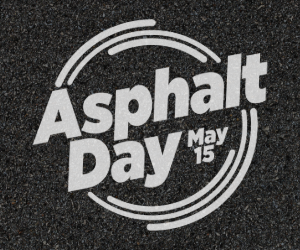Transportation Departments in the Southwest have been using Asphalt Rubber (AR) for several decades and it has successfully reduced pavement rutting, and improved skid resistance, ride quality and durability, as well as reduced noise levels on and nearby the highways. Now AR is gaining use in the Northeast, Midwest and Pacific Northwest.
For a number of years, the Arizona Department of Transportation (DOT) has used AR as a pavement preservation strategy on major highways throughout the state. Moreover, the city of Phoenix pioneered the use of asphalt rubber in the mid-1960s. Its earliest use was when it was incorporated into the city’s chip-seal program for city streets.
Key Differences
It is important to distinguish between asphalt rubber and rubberized asphalt, which are very different in composition and performance. AR is defined by ASTM as a blend of hot paving grade asphalt cement, reclaimed tire rubber and additives, in which the rubber content is at least 15 percent by weight of the liquid asphalt binder and has reacted sufficiently to cause swelling of the rubber particles. Rubberized asphalt is a term applied to asphalt with less than 15 percent by weight rubber content—for example terminal blends that may have rubber contents of 5 percent or less.
Early Projects
The AR that Phoenix used consisted of crumb rubber—or ground up used tires—mixed with liquid asphalt binder. An AR chip-seal was applied to Indian School Road from Central Avenue to 7th Street in 1971 as a temporary measure. It performed so well that the street was not reconstructed until 20 years later.
A few years earlier, the city began using an asphalt rubber hot mix to add one-inch overlays to prolong the life of city streets. Approximately 1,500 to 2,000 old tires are used for every lane-mile of paving for a two-inch AR overlay. During the 1990s, the city resurfaced more than 200 miles of streets with 450,000 tons of AR, which used about 1.1 million old tires. City engineers continue to use asphalt rubber hot mix as the primary overlay material in their arterial street maintenance program.
The Arizona DOT started using an asphalt rubber program in 1988. They have used more than 4.2 million tons of AR in their paving projects since 1988, valued at $225 million and resulting in the recycling of 15 million old tires. The benefits of AR include reduced long-term maintenance costs and, more important, improved safety conditions that can reduce serious driving accidents in both wet and dry conditions.
Growing Use
Despite highly successful programs in Arizona, Nevada, Texas and California, the rest of the United States has been slow to embrace asphalt rubber for many reasons. There was resistance to an unfunded mandate through the Intermodal Surface Transportation Efficiency Act of 1990, during which time the AR process was controlled by patents. Also, there were some unsuccessful projects in the 80s and early 90s, which were attributable to application problems and confusion of AR with other rubber-modified asphalt products. Since the early 90s, dramatic improvements have been developed in the blending equipment used to produce AR. This, along with greater experience and field studies, has encouraged many more states to explore the benefits of this technology.
Asphalt Rubber in New Jersey
Recently, the New Jersey DOT (NJDOT) paved a section of Route 95 with asphalt rubber from recycled tires. The pavement was designed to reduce noise levels in neighboring communities.
Approximately 80,000 old tires were used to create the paving mix. Tests by NJDOT have shown that the rubber pavement is extremely durable, provides excellent skid resistance, as well as good ride quality and improved visibility. In addition, the agency found that its AR costs less to maintain than traditional pavement and that it substantially reduced highway noise.
“The use of asphalt rubber pavement reflects the NJDOT’s commitment to maintain a safe and environmentally friendly roadway network,” said Commissioner Kris Kolluri. He adds that saving money is another factor because asphalt rubber is much less expensive than constructing noise walls.
The quiet pavement section on Route 95 is part of a $19 million New Jersey resurfacing project. The project included resurfacing Route 95—north and southbound lanes—from milepost 0.2 to milepost 2.3, and from milepost 3.35 to the Route 1 interchange at milepost 8.77. NJDOT engineers believe the new pavement will extend the life of the roadway by 15 to 20 years.
A Good Neighbor
NJDOT highway engineers like asphalt rubber pavement because it not only adds durability but also has an environmental bonus. “The road is a good neighbor,” said Bob Sauber, Chief Pavement Engineer on the paving project. “The new roadway is so much better, quieter and helps to shed ice.
“It also helps the environment,” he added. “The fact that we are using 80,000 old tires for the project that would normally end up in landfills is important. The pavement is also durable and skid resistant, reduces road spray and improves visibility.”
Asphalt Rubber in Washington State
Highway noise is a common complaint across the state of Washington. Residents near the highways say they want a highway pavement that will reduce traffic noise. Consequently, the Washington DOT (WSDOT) is testing quiet pavement sections on I-5, I-405, and State Route 520.
WSDOT engineers were challenged to design pavements that reduced noise while simultaneously providing durable, smooth and safe surfaces. “We’re studying quieter pavements to test their durability against ever-changing driving conditions such as heavy rain, snow, ice and studded tires,” said one WSDOT engineer. “WSDOT wants to know how long the pavement’s noise-reducing qualities will last and how much noise they eliminate.”
WSDOT selected the section of SR 520 because they needed a section of highway that had high traffic volumes and required minimal preparation prior to installation of the quiet pavement. WSDOT will study this section of SR 520 to measure its durability, the quantity and quality of noise reduction, and how the pavement performs over time.
WSDOT will use the study data to analyze the effectiveness of asphalt rubber pavement and to help them make informed decisions about using quiet pavements in their future highway projects.
Rising Demand
As awareness of the performance and environmental aspects of rubber asphalt pavement increase around the United States, so does its use. In the past few years, highway engineers have become increasingly aware of its performance advantages. They are finding that asphalt rubber resists rutting, aging and cracking, and it helps make roads safer by improving skid resistance and reducing road spray.
“Asphalt rubber is also quieter, which adds peace and quiet in the neighborhoods,” says Diane Graham, CEO of ECOPATH, manufacturer of asphalt rubber blending units used throughout the southwest and by the New Jersey and Washington State DOTs on their quiet pavement projects. “We’re also very excited about bringing asphalt rubber to the city of Denver. This will help to dispel the myth that asphalt rubber is only for warm climates, which is completely untrue. We know the projects in Denver, New Jersey and Washington State will clearly demonstrate the durability of AR in cold climates because it was demonstrated in Flagstaff, Arizona, which gets up to 100 inches of snow per year.”
Not only is the market for asphalt rubber growing throughout the United States, but the product has entered the world market as well. ECOPATH recently sold four asphalt blending units to Surgutneftgas, one of Russia’s prominent oil and gas companies and another unit to Asfaltomeros in Spain, one of the European pacesetters in the asphalt rubber industry.
|
Noise Reduction – An Environmental Bonus Asphalt Rubber has been used for more than three decades to resurface highways and city streets in Arizona. While it has been recognized for its performance and durability, the pavement is now seen as having a definite environmental bonus. Asphalt rubber pavement not only helps reduce the number of old tires in our landfills, but reduces traffic noise on highways and streets. Traffic noise typically ranges between 55 and 80 decibels along a highway. According to the FHWA, roadway noise makes an impact at 67 decibels. This is when people standing a few feet apart have trouble hearing each other in normal conversation. Most people only discern a difference in noise level when there is a three or more decibel change. But a three decibel change is the equivalent of doubling traffic volumes—like doubling road traffic from 1,000 to 2,000 vehicles. Noise readings have shown that asphalt rubber reduces tire noise by an average of four decibels. Noise tests by the city of Phoenix on asphalt rubber pavement on 7 th Street showed a decrease of about 10 decibels, or about a 90 percent reduction in noise level. Noise studies also show that a reduction in noise levels of 50 to 75 percent is commonly attained with rubber asphalt pavement. A Quiet Pavement Program has been developed by the Arizona DOT in cooperation with the Maricopa Association of Governments, the regional transportation planning body, and area cities. The $34 million program involves resurfacing about 115 miles of freeway in the Phoenix area with asphalt rubber and will be completed over a three-year period. |













